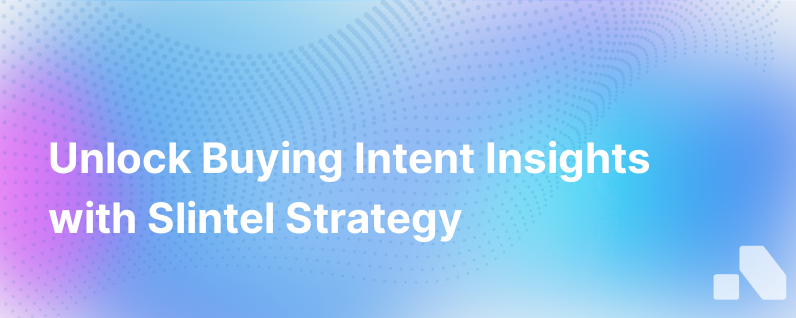Buying Intent Slintel
Published on December 1, 2023 by David Zhang
Understanding buyer intent is like having a crystal ball in the realm of B2B sales and marketing. It's about knowing which prospects are actively in the market for your products or services and tailoring your strategies accordingly. But gaining insights into buying intent isn't merely guesswork; it's a strategic process that involves data analysis and thoughtful engagement.
In this era of digital transformation, buyer intent data providers like Slintel have emerged as essential tools for businesses looking to identify and engage with potential buyers at the most opportune time. So let's dive into the nuances of buying intent and unravel how platforms like Slintel are revolutionizing the B2B landscape.
What is Buying Intent?
Buying intent refers to the likelihood that a consumer or business will purchase a product or service based on their behavior and engagement level. In the digital landscape, this means analyzing various signals such as web page visits, content downloads, webinar signups, and product reviews.
However, buying intent isn't a homogenous indicator. It operates on a spectrum, ranging from passive interest to active evaluation stages. Understanding where a prospect lies within this spectrum can significantly enhance a seller's ability to convert interest into revenue.
Why Is Buying Intent Data Critical?
The digital breadcrumbs that potential customers leave as they navigate the online world are valuable clues. Collecting and analyzing these signals can empower your sales and marketing teams to:
- Discover accounts that are in the market and actively researching a purchase
- Prioritize leads that show a higher propensity to buy
- Engage prospects with more personalized and relevant messaging
- Time their outreach to align with the prospect's buying journey
- Optimize marketing spend by focusing on high-intent signals
How Does Slintel Capture Buying Intent Data?
Platforms like Slintel aggregate intent data from various sources to provide a comprehensive view of a buyer's journey. Here’s how Slintel stands out in the landscape of buying intent:
Data Aggregation: Slintel collects data across the web, analyzing billions of data points, including technology adoption patterns, hiring trends, and user sentiment through product reviews.
Technographics: By understanding what technologies companies currently use, Slintel gives insights into buying patterns and preferences, indicating when a company might be primed to switch or upgrade their tools.
Lead Scoring: With its built-in analytics, Slintel scores leads based on their online behavior and interaction patterns, helping prioritize sales efforts towards high-quality prospects.
Market Signals: Slintel looks for specific market signals — like funding news, company growth, and executive movements — that typically precede buying decisions.
Sales Intelligence: Beyond intent data, Slintel offers comprehensive insight into prospects, including decision-makers’ contact info, insights into the organizational hierarchy, and more, to ensure a personalized, well-informed approach.
The Strategic Application of Buying Intent Data
But having access to intent data is only one piece of the puzzle. Here’s how businesses should strategically utilize these insights:
Tailored Messaging: By knowing what a prospect is interested in, companies can customize their sales pitches and marketing collateral to address specific pain points.
Timing and Cadence: With insights into buying stages, businesses can time their outreach to coincide with when a prospect is most receptive.
Content Personalization: Intent data reveals the topics and solutions that resonate with your target audience, which can inform content creation.
Account-Based Marketing Efforts: Buying intent data is particularly useful in ABM strategies, enabling highly targeted and efficient use of resources.
Product Development Insights: Long-term, intent data can inform product updates and new offerings based on market demands.
Challenges and Best Practices
Despite the clear advantages of buying intent data, its effective use is not without challenges. Here are common obstacles and best practices to overcome them:
Data Overload: It can be overwhelming and difficult to decipher. Focus on the data most relevant to your business goals and implement robust filtering mechanisms.
Integration with Existing Systems: For intent data to be actionable, it needs to be integrated with your existing CRM and marketing automation systems. Seamless integration ensures sales and marketing teams have the data they need at their fingertips.
Maintaining Data Privacy Compliance: With increasing data privacy regulations, it’s essential to ensure that your intent data sources and usage comply with GDPR, CCPA, and other relevant legislation.
Regular Data Review and Cleaning: Intent data isn't static; it's vital to continually validate and clean your databases to maintain accuracy.
Training Your Team: You must adequately educate your sales and marketing teams on interpreting and using buying intent data effectively.
Conclusion
In the B2B sales and marketing arena, the ability to anticipate and respond to a prospect’s buying intent is invaluable. Platforms like Slintel offer a sophisticated blend of technology and insights to equip businesses with the information they need to target and engage prospects with precision and finescale.
As we transition into a future where data-driven strategies predominate, integrating buying intent data into your sales and marketing initiatives becomes not merely an advantage but a necessity. By using intent data judiciously and responsibly, you can elevate lead nurturing, increase conversion rates, and ultimately drive revenue growth — making Slintel a vital partner in the journey toward business success.